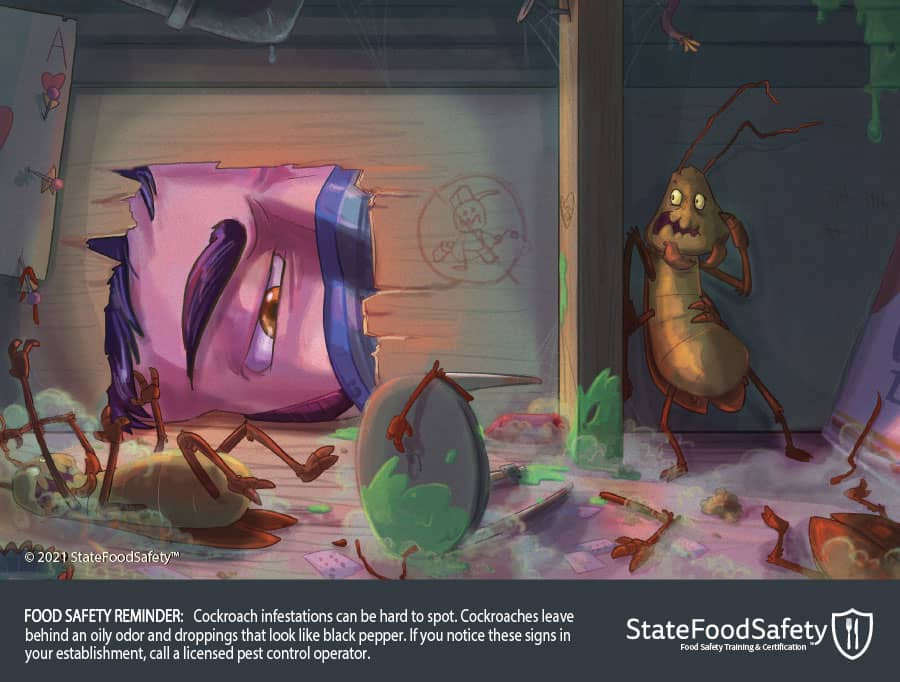Maintaining a welcoming kitchen environment is crucial in any food service establishment, but there’s one unwelcome guest that should never be tolerated: cockroaches. These pests are vectors for harmful bacteria like staphylococcus and salmonella, posing a significant threat to food safety and hygiene. Keeping cockroaches away from food preparation and storage areas is paramount.
 Humorous cartoon of a cockroach infestation in a commercial kitchen, a critical concern for food safety inspections.
Humorous cartoon of a cockroach infestation in a commercial kitchen, a critical concern for food safety inspections.
Cockroach infestations can be challenging to detect early due to their small size and nocturnal habits. Food workers need to be vigilant and aware of potential entry points such as cracks in walls, unsecured windows, ventilation systems, and door gaps. Beyond preventative measures, recognizing the early warning signs of a cockroach problem is essential for prompt action. Here are four key indicators that food workers should be aware of:
1. Pepper-like Droppings: An Initial Sign of Cockroaches
One of the first noticeable signs of a cockroach presence is their droppings. These appear as minuscule dark specks, often mistaken for spilled black pepper. If food workers observe what seems to be scattered black pepper granules on floors, countertops, or shelving, especially in food storage or preparation zones, it warrants closer inspection for further evidence of cockroaches.
2. Strong, Oily Odor: A Distinct Cockroach Infestation Smell
Cockroaches secrete an oily substance that allows them to navigate tight spaces and also serves as a pheromone trail, guiding other cockroaches to food sources and aggregation points. This secretion produces a characteristic musty, oily, or even slightly sweet odor that can become quite pungent in cases of significant infestation. If food workers detect an unusual oily smell in areas where food is stored or prepared, it should raise suspicion and prompt a search for other cockroach signs.
3. Egg Casings: Evidence of Cockroach Reproduction
Cockroach egg casings, also known as oothecae, are small, purse-shaped shells that contain multiple cockroach eggs. These casings are typically dark in color, ranging from black to brown or dark reddish hues. Finding egg casings is a clear indication of cockroach breeding and a potentially established infestation. Food workers should be trained to recognize these casings, which might be found in hidden locations like behind equipment, in storage areas, or near cracks and crevices.
4. Cockroach Sighting: Direct Confirmation of Pest Presence
The most definitive sign of a cockroach problem is, of course, actually seeing a live cockroach. These pests are nocturnal and prefer dark, secluded environments. Food workers are most likely to spot cockroaches in dimly lit areas, such as cracks in walls, underneath cabinets and appliances (ovens, refrigerators, dishwashers), or in storage rooms. They may also be found near moisture sources or food debris. Even a single cockroach sighting should be considered a potential warning sign that warrants further investigation and possible pest control intervention.
If food workers observe cockroach egg casings or spot live cockroaches within the food establishment, it signifies an existing pest control issue that requires immediate attention.
Immediate Steps Upon Discovering Cockroaches
Upon suspecting or confirming a cockroach infestation, food workers should immediately inform their manager or supervisor. If you are the manager, it is crucial to contact a certified pest control professional without delay. Provide the pest control operator with specific details about the signs observed, locations of sightings, and any other relevant information to help them assess the severity of the problem and develop an effective treatment plan.
The critical point is to act swiftly at the first sign of cockroaches, rather than waiting for multiple indicators to appear. Early intervention by pest control experts is essential to prevent a minor cockroach issue from escalating into a full-blown infestation that can compromise food safety and business reputation.
Preventing Cockroach Infestations in Food Establishments
Cockroaches, like all pests, are attracted to food, water, and shelter. Maintaining strict cleanliness and sanitation practices is the most effective way to prevent cockroach infestations. Regular trash removal, thorough cleaning of indoor and outdoor dumpster areas, and adherence to a comprehensive cleaning schedule are essential. This schedule should encompass all food-contact surfaces, equipment, and food storage areas to ensure they remain clean and sanitized.
Proper food storage is another key preventative measure. Storing food items at least 6 inches off the floor and away from walls reduces cockroach access and harborage opportunities. Similarly, keeping wet mops elevated and off the floor prevents cockroaches from using them as hiding places.
Finally, proactive sealing of potential cockroach entry points is crucial. This includes sealing cracks and gaps in walls and around pipes, installing screens on windows and vents, and ensuring doors remain closed as much as possible to deny cockroaches entry to the facility.

